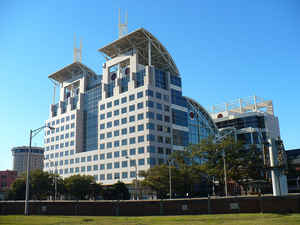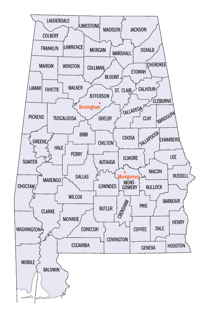Mobile County, Alabama History
Mobile County Education, Geography, and History
Mobile County is the second most-populous county in the state of Alabama. Based on the 2010 census, its
population was 412,992. Mobile County was
created on December 18, 1812 from Mobile District of West
Florida after annexation into Mississippi Territory. The county
seat is Mobile, Alabama. Mobile county is named in honor of the indigenous Maubila tribe.
Mobile County comprises the Mobile, Alabama Metropolitan Statistical Area.
Etymology - Origin of Mobile County Name
Mobile county and the city of Mobile derive their name from Fort Louis de la Mobile, a French fortification erected near Mount Vernon in 1702.
Demographics:
County QuickFacts: CensusBureau Quick Facts
Mobile County History
Mobile County, Alabama
This area was occupied for thousands of years by varying cultures of indigenous peoples. The historic Choctaw had occupied this area along what became called the Mobile River when encountered by early French traders and colonists, who founded Mobile in the early eighteenth century. The British took over the territory in 1763 (along with other French territories east of the Mississippi River) after defeating the French in the Seven Years' War. During the American Revolutionary War, it came under Spanish rule as part of Spanish Florida. Spain ceded the territory to the United States after the War of 1812.
Mobile county was formed by proclamation of Gov. Holmes of the Mississippi Territory on December 18, 1812. Mobile County is located in the southwestern corner of the State of Alabama, and is bordered by the State of Mississippi on the west, Washington County on the north, Baldwin County and Mobile Bay on the east, and the Gulf of Mexico on the south. It encompasses 1, 238 square miles. The city of Mobile is the county seat. Both the city and the county derive their name from Fort Louis de la Mobile, a French fortification erected near Mount Vernon in 1702. The word Mobile is believed to come from a Choctaw Indian word for "paddlers." The area was occupied by the French from 1702-63, by the British from 1763-80, and by the Spanish from 1780-1813. Courthouse fires occurred in 1823, 1840, and 1872. Other towns and communities include Citronelle, Bayou LeBatre, and Theodore.
In the 1830s, the United States forced the removal of most of the Native Americans in the area under President Andrew Jackson's policy to
relocate them to Indian Territory west of the Mississippi River. Many of those who remained continued their culture; since the late 20th
century, several tribes have reorganized and gained state recognition. Among those is the MOWA Band of Choctaw Indians, which was recognized
as a tribe in 1979 by the state, but not federally; it occupies land along the border of Mobile and Washington counties.
After more than a century of European settlement, Mobile County was organized by the legislature and the proclamation of Governor Holmes of
the Mississippi Territory on December 18, 1812. When Mississippi was separated and admitted as a state on August 15, 1817, Mobile County
became part of what was called the Alabama Territory. Two years later, the county became part of the state of Alabama, granted statehood on
December 14, 1819.
The city of Mobile, first settled by French colonists in the early 18th century as part of La Louisiane, was designated as the county seat
from the early days of the county. Both the county and city derive their name from Fort Louis de la Mobile, a French fortification established
(near present-day Axis, Alabama) in 1702. The word "Mobile" is believed to stem from a Choctaw Indian word for "paddlers". The area was
occupied by French colonists from 1702-1763, whose influence was strong in the city. It was ruled by the British from 1763-1780, when more
American colonists began to enter the territory; and controlled by the Spanish from 1780-1813.
At the end of the War of 1812, the United States took over the territory. At that time, new settlers were being attracted to the land, eager
to develop short-staple cotton in the uplands area. Invention of the cotton gin made processing of this type of cotton profitable, stimulating
wholesale development of new cotton plantations in the Black Belt during the antebellum years. Mobile developed as a major port for export of
cotton.
Courthouse fires occurred in the years 1823, 1840, and 1872
Geography: Land and Water
As reported by the Census Bureau, the county has a total area of 1,644 square miles (4,260 km2), of which 1,229 square miles (3,180 km2) is land and 415 square miles (1,070 km2) (25.2%) is water. It is the fourth-largest county in Alabama by land area and second-largest by total area. It includes several islands, including Dauphin Island, Gaillard Island and Mon Louis Island.
Three miles off Mobile County's coast, at the entrance to Mobile Bay, is Dauphin Island, a subtropical Gulf Coast barrier island that is 14 miles long and 1? miles wide at its widest point. It is estimated that there are 1,300 permanent residents living on the island.
Neighboring Counties
Bordering counties are as follows:
- North: Washington County
- East: Baldwin County
- South: Gulf of Mexico
- Southwest: Jackson County, Miss.
- Northwest: George County, Miss.; Greene County, Miss.
Education
In most areas of Mobile County, schools are operated by the Mobile County Public School System. The cities of Chickasaw, Saraland, and
Satsuma have separate school systems. Each is served by Chickasaw City Schools, Saraland Board of Education, and Satsuma City School System.
Mobile County is also the home of the University of South Alabama (USA), a public research university divided into ten colleges, including one
of Alabama's two state-supported medical schools. USA has an enrollment of over 16,000 students and employs more than 6,000 faculty,
administrators, and support staff.







